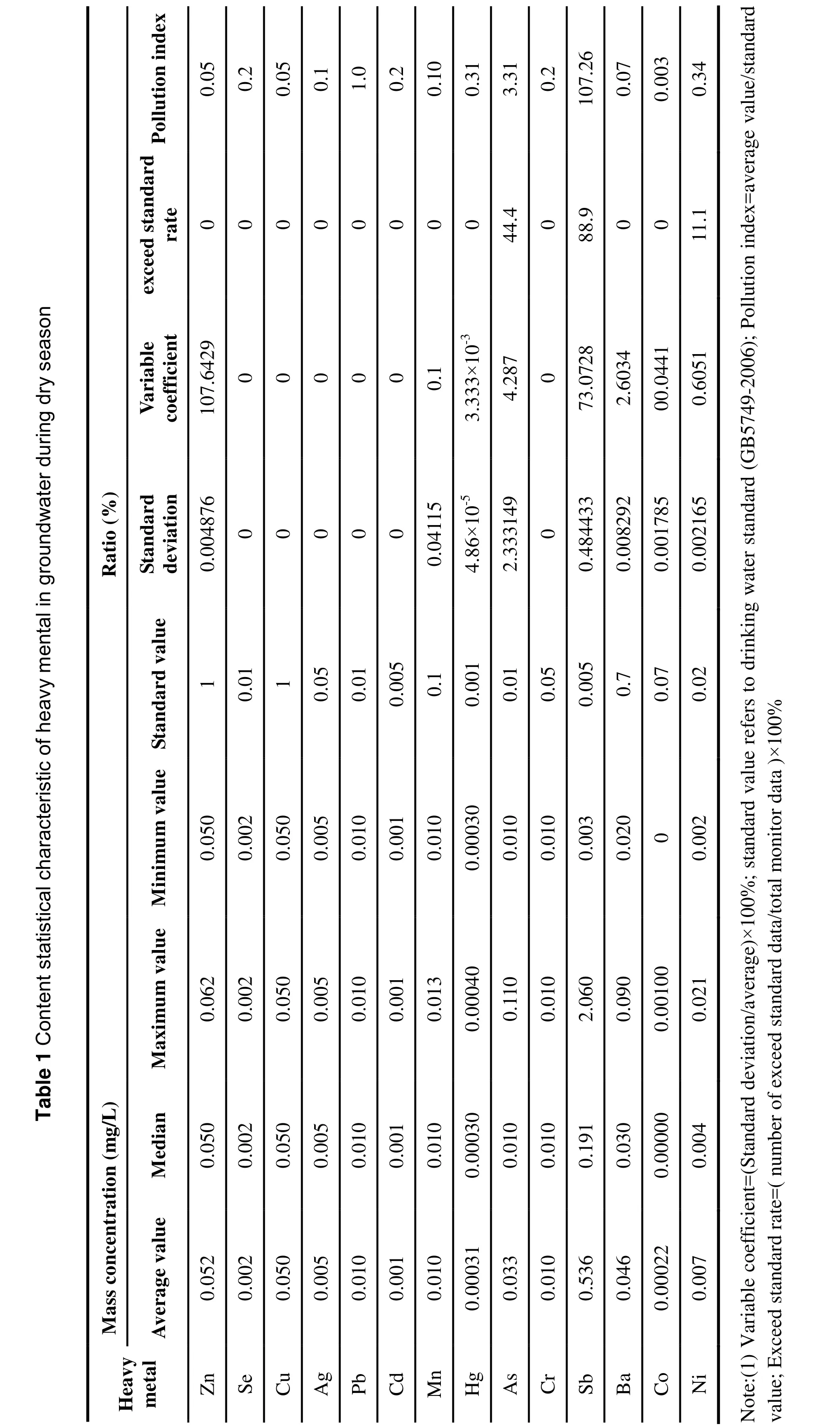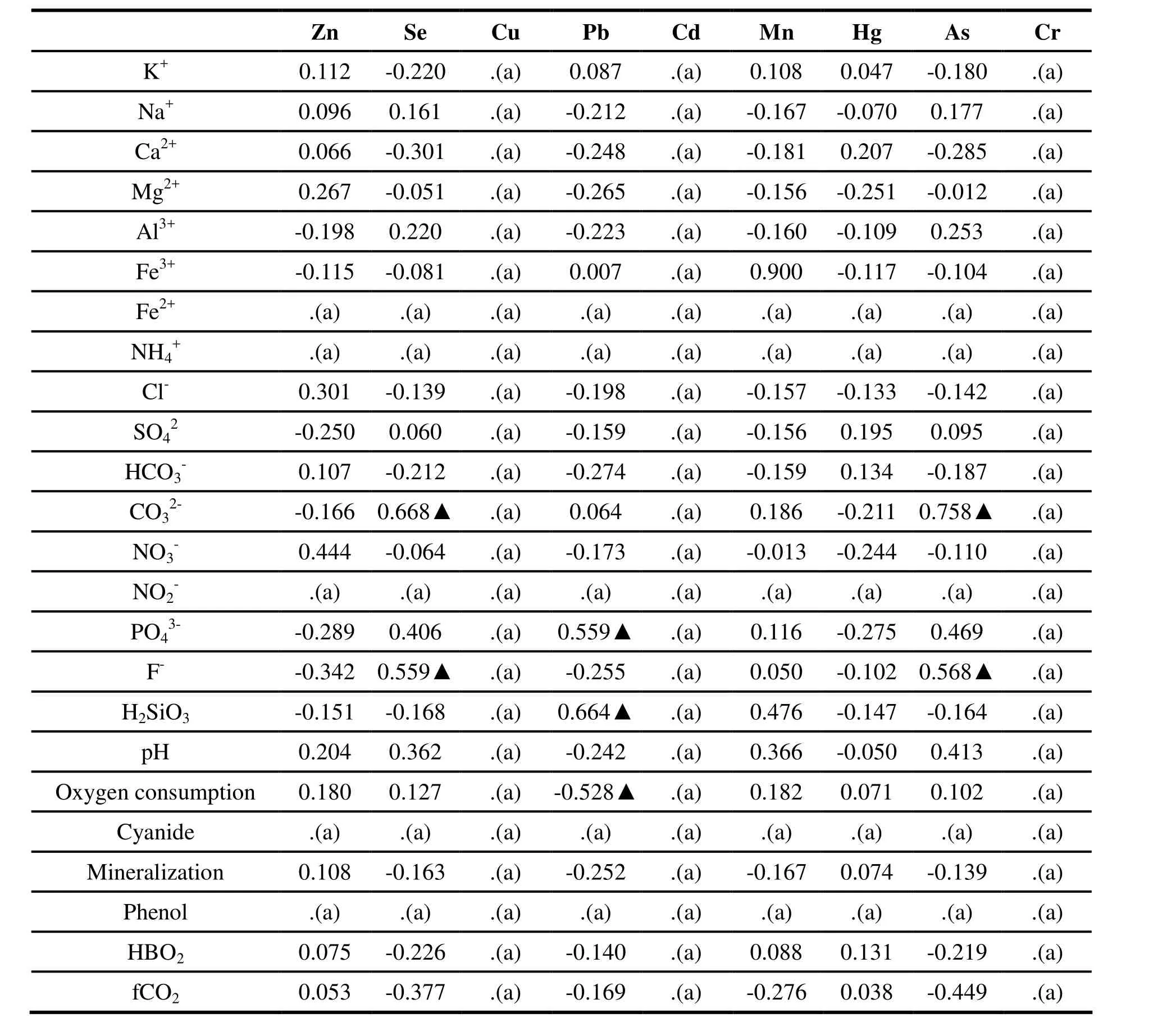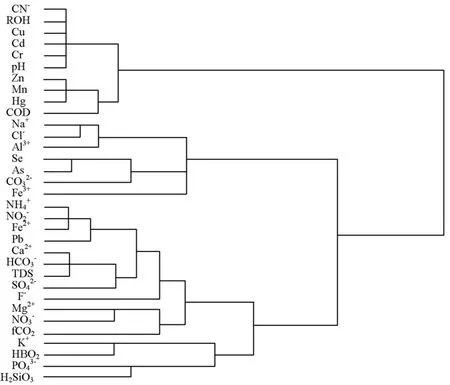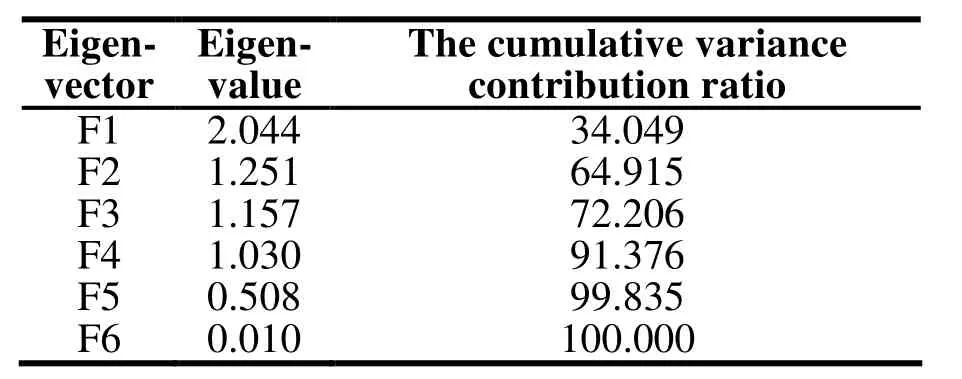Statistical characteristics of heavy metals content in groundwater and their interrelationships in a certain antimony mine area
2016-11-25YUKainingLIJianLIHuiCHENKangLVBingxuZHAOLonghui
YU Kai-ning, LI Jian, LI Hui, CHEN Kang, LV Bing-xu, ZHAO Long-hui
1Hebei GEO University, Shijiazhuang 050031, China.
2 Hebei Province Key Laboratory of Sustained Utilization and Development of Water Resources, Shijiazhuang 050031,China.
3Geological Environment Monitoring Station of Hunan province, Changsha 410007, China.
4Shijiazhuang Comprehensive Geological Brigade, Hebei Geology and Mineral Bureau, Shijiazhuang 050085, China.
Abstract: In recent years, most of domestic and foreign researches about heavy metal pollutions of metal mine mainly focus on water, soil and plants on the surface. There is lack of researches about heavy metal pollution in groundwater of metal mine. In this research, a certain antimony mine area is selected as a typical study area. Also, the study about statistical characteristics of heavy metals in groundwater has been carried out. Furthermore, the interrelationships have been preliminarily discussed through related analysis, such as relevant analysis, cluster analysis and principle component analysis. The results show that: the excessive elements in groundwater of study area are Sb, As, Pb, Se, and Ni. The average mass concentration of Sb, As, and Pb is higher than that of drinking water standards (GB5749-2006).The concentration of most heavy metals in dry season is lower than or equal to that in wet season for groundwater. Zn is the only metal in groundwater showing a different pattern, the concentration of which in dry season is higher than that in wet season. Under the impacts of stratum leaching and absorption effect, the concentration of heavy metals (except Pb and Ba)in groundwater are lower than or equal to that in surface water. As and Se, the two heavy metals have a significant positive correlation, which shows the two elements might have gone through similar environmental geochemical effect. Also, the connection among Zn, Hg, Pb, and Mn is not obvious; therefore, the sources of those elements are quite different. In addition, the elements of Se and As have obvious positive interrelationship with elements of CO32- and F-.Also, the Pb has significant positive correlation with PO43-, H2SiO3 and oxygen consumption.The results of cluster analysis show that 9 different heavy metals in the study area can be divided into 3 categories: Zn, Cd, Mn, Hg, Cu, and Cr belong to the first category, Se and As belong to the second one, and the last category is Pb. Also, the principle component analysis divides 6 heavy metals (Zn, As, Hg, Pb, Mn, and Se) into 4 different principle components,which can be utilized to assess heavy metals pollution situations in groundwater. The reliability of this method is higher than 91%. Moreover, the research provides theory basis and models for establishing evaluation index system and exploring the evaluation method of heavy mental pollution in groundwater.
Keywords: Groundwater; Heavy metals; Content; Statistical characteristics; Interrelationships;Antimony mine
Introduction
The exploitation of mineral resources plays an important role in promoting the development of social economy and improving people’s living standards. At the same time, the development of mineral resources has also led to serious pollution of mine environment and the destruction of ecological balance. Particularly the exploitation of metal mine has led to heavy metal pollution. The exploitation of metal mining and smelting activity has exposed the underground miners, leading to the release of heavy metals in minerals. The heavy metals in minerals and in its surrounding rocks come into surface water, groundwater, air and soil in mining area and the surrounding areas, in the form of waste water, waste residue and waste air,causing serious heavy mental eco-environment pollution of local and surrounding area. The pollutants would enter the human food chain through the aquatic system and soil-plant system,harming people’s health.
At present, the domestic and foreign scholars conducted research on heavy metal pollution mainly focusing on the heavy metal pollution in surface water body (sediment mud) in soil and plant (XIE Wen-yan et al. 2011; ZHA Xue-fang,2006; LIU Hui et al. 2011; ZHANG Bo et al.2011). There are less researches on heavy metal pollution in groundwater (HE Xiao-wen et al. 2011;HUANG Guan-xing et al. 2011; LI Tao and YANG Jun-cang, 2008; WU Dun-ao, 1993). Metal mine has some research results about the heavy metal content in soil and vegetation, and the pollution(WU Chao and LIAO Guo-li, 2006; ZHANG Jin-de et al. 2009; LIAO Guo-li and WU Chao,2005; XU You-ning et al. 2009; LEI Ming et al.2008; TONG Fang-ping et al. 2008; SHE Wei et al.2010).
But the study of heavy metals in groundwater is rarely reported. LEI Ming and others (LEI Ming et al. 2008) conducted researches of heavy metal elements in paddy soil in mining and smelting areas and evaluated its potential risk, finding that in the paddy soil, the content of heavy metal Cd,As, Cu and Pb are in logarithmic normal distribution, which means that the potential ecological risk is high. SHE wei and others (SHE Wei et al. 2010) studied the absorption and accumulation characteristics of ramie for heavy metals in the soil.
The study chooses an antimony mining area as a typical research area. In the research we collect water samples for chemical composition quantitative analysis and study the statistical characteristics of heavy metal content in groundwater in mining area. And through interrelationship analysis, cluster analysis and principle component analysis, the thesis discussed the relationship between groundwater and heavy metals. The research provides theory basis and models for establishing evaluation index system of heavy mental pollution in groundwater, exploring the evaluation method of heavy mental pollution in groundwater, conducting research on monitoring technology and method and monitoring system of heavy metal groundwater.
1 Profile of study area and sample collection
Lengshui City, a mining city, is located in Hunan Province and covers an area of 432 km2.The history of coal exploiting in this city expands over 600 years, from Hongwu a fifteenth year(1383) of the Ming Dynasty till now. Antimony mining exploitation in Xikuangshan began in 1897 with a history of more than a hundred years.Lengshui City has the name of “World Antimony Capital” and “Jiangnan Coal Sea”, with mining industry as its pillar industry. Because of the numerous mines and their long history, the unceasing mine expansion, the mining activities induce a large number of geological disasters and seriously damage the mine environment, it also poses threats to people’s life and property.Geological disasters and mine environmental geological problems have become a major obstacle for regional economic development. The antimony mining area is a century-old mine with dense population. The “World Antimony Capital” has typical geological environment problems, demonstrating serious soil and water pollution. As a result,this antimony mining area was chosen as typical area for the research.
This study takes samples from the monitoring data of Hunan geological environment monitoring station in one Xikuangshan area. Water samples were collected from 12 places (scattering in villages, surrounding area of mine and main streams), among which there are 4 surface water samples, 8 groundwater samples, and 25 sample data.

?

Table 2 Content statistical characteristic of heavy mental in groundwater during wet season
2 Data analysis
2.1 Content statistical characteristic of heavy mental in groundwater
Comparing the test results of heavy metal in 25 samples (without testing Sb, Ba, Ni, Co, of underground water in wet season) with the standard of drinking water (GB5749-2006), and through statistical analysis by SPSS, the results are demonstrated in Table 1 and Table 2.
As can be seen in table 1, during the dry season,the exceeding standard rate of Sb, As and Ni are 88.9%, 44.4% and 11.1% respectively, and the exceeding standard rate of other heavy metals is 0;Heavy metal pollution index is Sb > As > Pb > Ni> Hg > Se = Cd = Cr > Ag = Mn > Ba > Zn = Cu >Co. The pollution index of Sb and As is 107.26 and 3.31 respectively. From the Table 2, during the wet season, the exceeding standard ratio of As, Pb and Se are 75%, 37.5% and 12.5% respectively,and that of other heavy metals pollution 0. The pollution index of heavy metal is As > Pb > Se >Hg > Cd > Mn = Cr > Zn = Cu, among them, the pollution index of As and Pb is 40.14 and 1.26.Therefore, the groundwater heavy metals that exceed the standard are Sb, As, Pb, Se, Ni, and the average mass concentration of Sb, As, Pb exceeds the standards of drinking water (GB5749-2006).
Table 3 demonstrates the ratio of heavy mental content in dry season and wet season. It shows that in surface water, most of heavy metal content in dry season is larger than or equal to that in wet season. The content of Zn, Mn and Hg in dry season is larger than that of wet season (the content of Zn in dry season is 5.2 times that of wet season). The content of Se and As in dry season is smaller than that of wet season. The content of other elements are similar. In groundwater, the content of most of the heavy metal in dry season is less than or equal to that of the wet season. The content of Zn in dry season is larger that of wet season. And the content of Mn, Hg, Pb, Se and As is smaller than that of dry season. The content of other elements is similar.
2.2 Interrelationship of heavy mental in groundwater
Based on analysis of the relationship of heavy metal elements obtained from material of water quality in the study area, the research finds that the interrelationships of these elements are low; the results are shown in Table 4.Zn Se Cu Pb Cd Mn Hg As Cr

Table 3 Table of ratio, r of heavy mental content in dry season and wet season

Table 4 Analysis of interrelationship between pollution indexes of heavy mentals in groundwater
According to the statistical analysis theory, the significance levelα=0.05, when the correlation coefficient r > rα(r=0.1689), it is regarded as interrelated. Accordingly, in Table 4, there is interrelationship between elements Zn and Hg, Se and As, Pb and Hg, Mn and Hg. Under the significance level of 0.05, heavy metals Zn, Se, Pb,Mn, Hg, As are all related, only Se and As have extremely significant correlation, the correlation of the rest of the elements is rather weak. The significance levelαis reduced,α= 0.01 (i.e.,increase the correlation credibility), then r=0.2316.So only Se and As meet r > rα.
The boy and his father looked at the handsome fish, gills playing back and forth8 in the moonlight. The father lit a match and looked at his watch. It was 10 P.M.-- two hours before the season opened. He looked at the fish, then at the boy.
Se and As have extremely significant positive correlation. Zn, Pb, Mn and Hg have certain correlation but very weak. In samples with high content of Se, the content of As is relatively high.In the sample with high content of the Pb and Mn,the content of Hg is relatively low. So As and Se may undergo similar environmental geochemistry action, and the origin of other heavy metals is different. The content of Cu, Cd and total Cr do not change in any sample, which makes it impossible to find out the correlation between these elements and other heavy metals.
2.3 Interrelationship between heavy metal and other composition
The analysis results of correlation between heavy metals and other chemical composition are shown in Table 5. Table 5 shows that Se and As have significant positive correlation CO32-and F-,which indicates that high concentrated CO32-and F-facilitate Se and As enrichment, as a result, the content of Se and As in the study area exceed the standard. While Pb also has significant positive correlation with PO43-, H2SiO3and oxygen consumption, it indicates that in the study area PO43-, H2SiO3, and oxygen consumption significantly influence Pb. However, there is no obvious significance between heavy metals and other chemical composition, which indicates that in the study area, the chemical composition has less influence on heavy metals. The content of heavy metals and pH (sample characteristic value in Table 6) have certain correlation, which means that in the study area, heavy metals in groundwater have certain correlation with acid and alkali conditions. Table 6 shows that the pH of groundwater is 7.2-8.16, it signifies weak alkaline environment. The content of Zn, Se, Mn and As increases with the increase of pH value, which is a positive correlation. The content of Pb and Hg decreases with the increase of pH value, which is a negative correlation.

Table 5 The correlation analysis of heavy metal in groundwater and other elements
2.4 Cluster analysis of heavy metals in groundwater and other composition
To find out chemical composition with more similarity with heavy metal in groundwater and understand the transition characteristics of the heavy metals in groundwater, the research conducted cluster analysis on 33 kinds of chemical composition in the study area, and the results are shown in Fig. 1.
Fig. 1 shows five groups with the best similarity, which are cyanide, phenols, Cu, Cr, pH;Zn, Mn, Hg; Se and As; NH4+, NO2-, Fe2+; Ca2+,HCO3-, and mineralization. On small measure,there are four groups with better similarity: Cd, Cr,Zn, Mn, Hg, pH and oxygen consumption; Na+, Cl-,Fe3+, Se, As and CO32-; NH4+, NO2-, Fe2+, Pb, Ca2+and HCO3-, mineralization, SO42-, F-, Mg2+, NO3-,fCO2; K+, HBO2, PO43-, H2SiO. On large measure,Cl-, Fe3+, F-, Se, As and PO43-, H2SiO3have certain similarity. In addition, the heavy metals in groundwater can be divided into three categories: Zn, Cd,Mn, Hg, Cu, Cr; Se, As; Pb. Se and As have the best similarity. This basically fit the interrelationship between heavy metals in Table 4.

Table 6 pH value of samples in study area

Fig. 1 Tree diagram of cluster analysis of chemical composition in groundwater
2.5 Analysis of principle component of heavy metals in groundwater
Because the numerous heavy metal elements can affect the groundwater, the author finds the main factors through principal component analysis and dimensionality reduction, these methods can help us to fully reflect the original variable information as much as possible and can directly reach the purpose of comprehensive evaluation.The principal component analysis on Zn, Se, Pb,Mn, Hg, As of 6 kinds of heavy metals (variance of Cu, Cr, Cd is zero, Sb, Ba, Ni and Co did not test during wet season of groundwater) is conducted and the characteristic value of each feature vector and the cumulative variance contribution ratio are calculated (see Table 7).
Based on principal component analysis(eigenvalue is greater than 1, the cumulative variance contribution ratio is greater than 80%),the former four feature vectors are selected as the main components, thus the relation function for the principal component is established, and the relationship between each heavy metal and the principal components is analysed.

Table 7 Characteristic value and the cumulative variance contribution ratio

The first expression of principal component,the coefficient ofXSeandXAsis large, reaching 0.989 and 0.994 respectively, the corresponding relatively high content of heavy metal in groundwater, reaching 0.059 mg/l and 2.41 mg/l respectively.
In the third expression of principal component,the coefficient ofXZnandXHgare large, reaching 0.903 and 0.517 respectively. At this moment the content of Zn reaches maximum value 0.062 mg/l.
In the fourth expression the principal component, the coefficient ofXPbandXMnare large, reaching 0.707 and 0.728 respectively. At this moment, the content of Pb reaches maximum of 0.022 mg/l.
The distribution of heavy metals in groundwater in the study area is analyzed from four aspects, using four principal components which are divided by Zn, Se, Pb, Mn, Hg and As which can be used to evaluate heavy metal pollution in groundwater with the reliability of more than 91%.
3 Conclusions
During dry season, the exceeding standard ratio of Sb, As, Ni in groundwater are 88.9%, 44.4%,11.1% respectively. And the exceeding standard ratio of other heavy metals is zero; In wet season,the exceeding standard ratio of Sb, As, Pb, Se, Ni are 75%, 37.5%, 12.5% respectively, and the exceeding standard ratio of other heavy metals is zero. Therefore, the element of heavy metals that exceeds standard in study area is Sb, As, Pb, Se, Ni with content of 0.01-2.06 mg/l, 0.01-2.41 mg/l,0.01-0.022 mg/l, 0.002-0.059 mg/l, 0.002-0.021 mg/l respectively, and the average mass concentration of Sb, As, Pb exceed the standard (GB5749-2006)of drinking water.
In the study area, the heavy mental content in dry season is smaller or equal to that of wet season;only the content of Zn is larger in dry season than that in wet season. Affected by dissolving and filtration effect and adsorbing effect, except Pb and Ba, the content of heavy metals in groundwater is smaller or equal to that in surface water.
In groundwater, As and Se have extremely significant positive correlation, showing that these two elements may undergo similar environment geochemistry action. But the correlation between Zn, Hg, Pb, Mn is not obvious, demonstrating that their origin is different. Se, As and CO32-, F-have significant positive correlation, indicating that in study area, PO43-, H2SiO3and oxygen consumption have great impact on Pb, but the pH of groundwater is 7.2-8.16, it is an alkalescency environment and has less impact on heavy metals.
The cluster analysis shows that in the study area, the similarity of 9 kinds of heavy metals in groundwater and other chemical composition can be divided into three groups: Zn, Cd, Mn, Hg, Cu,Cr; Se, As; Pb. The principle component analysis divided six heavy metals Zn, As, Hg, Pb, Mn and Se into four major compositions, this analysis has 91% reliability, and it is used to evaluate the heavy mental pollution in ground.
The exploitation of mines seriously pollutes surrounding environment and destroys ecological balance. The heavy mental pollution is very prominent but it lacks of relevant research. The research provides theory basis and models for establishing evaluation index system of heavy mental pollution in groundwater, exploring the evaluation method of heavy mental pollution in groundwater, conducting research on monitoring technology and method and monitoring system of heavy metal in groundwater.
Acknowledgements
This study is supported by Homeland Resource Non-Profit Research Special Funding Project(No. 200911036).
杂志排行
地下水科学与工程(英文版)的其它文章
- Building a scientific and ecological earth-on an important field of geo-science: Geo-environment and construction engineering effect
- A discussion of up-flow springs
- Thermal stresses analysis of casing string used in enhanced geothermal systems wells
- Groundwater resources in karst area in Southern China and sustainable utilization pattern
- Study on engineering-hydrogeological problems of hydroelectric project
- Interactions between benzotriazole and corncob biochars pyrolyzed at different temperature
